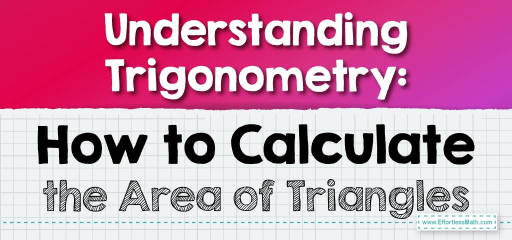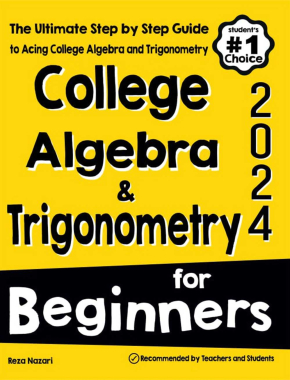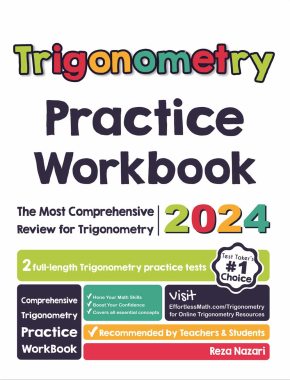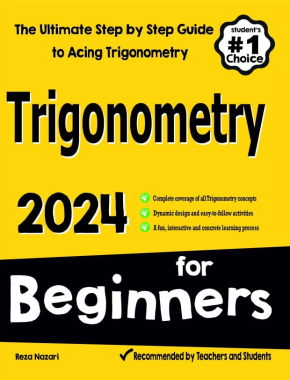Understanding Trigonometry: How to Calculate the Area of Triangles
The vast realm of trigonometry extends far beyond just sine, cosine, and tangent. Its principles have the power to simplify seemingly complex problems, such as finding the area of a triangle without knowing its height. By merging basic triangle area formulas with the magic of trigonometric ratios, we can unveil triangle areas in a whole new light. Intrigued? Let’s venture into the trigonometric technique to compute triangle areas.

Step-by-step Guide: Trigonometry and Area of Triangles
Basic Area of a Triangle:
The most common formula for finding the area of a triangle is:
\( \text{Area} = \frac{1}{2} \times \text{base} \times \text{height} \)
Introducing Trigonometry:
If two sides of a triangle and the included angle are known, the area can be determined using:
\( \text{Area} = \frac{1}{2} \times a \times b \times \sin(C) \)
Here, \(a\) and \(b\) are the two known sides, and \(C\) is the included angle between them.
Why Does This Work?:
The height in the standard formula can be expressed in terms of \(a\), \(b\), and \(C\). The height would be \(a \times \sin(C)\) (or equivalently, \(b \times \sin(A))\). By substituting this into the base-height formula, we get the trigonometric area formula.
Examples
Example 1:
Given a triangle \(ABC\) with side \(AB = 5 \text{ cm}\), side \(BC = 7 \text{ cm}\), and angle \(B = 60^\circ\), find the area of triangle \(ABC\).
Solution:
Using the trigonometric formula for area:
\( \text{Area} = \frac{1}{2} \times AB \times BC \times \sin(B) \)
\( \text{Area} = \frac{1}{2} \times 5 \text{ cm} \times 7 \text{ cm} \times \sin(60^\circ) \)
\( \text{Area} = 15.5 \text{ cm}^2 \) (approximately)
Example 2:
For triangle \(PQR\), side \(PQ = 8 \text{ cm}\), side \(QR = 10 \text{ cm}\), and angle \(Q = 45^\circ\), determine the area of triangle PQR.
Solution:
\( \text{Area} = \frac{1}{2} \times PQ \times QR \times \sin(Q) \)
\( \text{Area} = \frac{1}{2} \times 8 \text{ cm} \times 10 \text{ cm} \times \sin(45^\circ) \)
\( \text{Area} = 28.28 \text{ cm}^2 \) (approximately)
Practice Questions:
- Given triangle \(XYZ\) with \(XY = 6 \text{ cm}\), \(YZ = 9 \text{ cm}\), and angle \(Y = 30^\circ\), find its area.
- For triangle \(LMN\), if \(LM = 4 \text{ cm}\), \(MN = 5 \text{ cm}\), and angle \(M = 90^\circ\), calculate the area.

Answers:
- \( 13.5 \text{ cm}^2 \)
- \( 10 \text{ cm}^2 \)
Related to This Article
More math articles
- Reviewing Place Value on Numbers Up to a Billion
- How to Write Linear Functions from Tables
- How to Solve Systems of Equations? (+FREE Worksheet!)
- The Ultimate SSAT Middle-Level Math Course (+FREE Worksheets & Tests)
- 5th Grade NYSE Math Practice Test Questions
- 6th Grade SBAC Math Worksheets: FREE & Printable
- 7th Grade IAR Math Worksheets: FREE & Printable
- The Ultimate 6th Grade GMAS Math Course (+FREE Worksheets)
- 8th Grade OST Math FREE Sample Practice Questions
- 6th Grade MEAP Math Practice Test Questions














What people say about "Understanding Trigonometry: How to Calculate the Area of Triangles - Effortless Math: We Help Students Learn to LOVE Mathematics"?
No one replied yet.